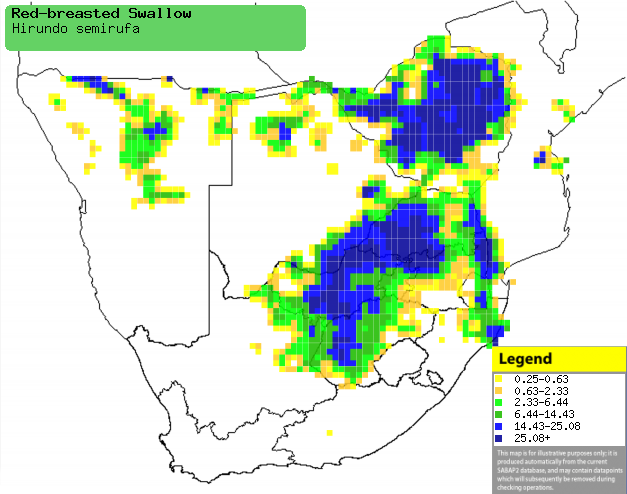|
Hirundo semirufa (Red-breasted
swallow)
Rooiborsswael [Afrikaans]; Sisampamema (generic term
for swallows, martins, swifts and spinetails) [Kwangali]; Lekabelane (generic
term for swallows or martins) [South Sotho]; Nyenganyenga (generic name for
swallow or martin) [Shona]; Nyengha leyi kulu [Tsonga]; Pêolwane, Phêtla
(generic terms for swifts, martins and swallows) [Tswana]; Roodborstzwaluw
[Dutch]; Hirondelle à ventre roux [French]; Rotbauchschwalbe [German];
Andorinha-de-peito-ruivo [Portuguese]
Life
> Eukaryotes >
Opisthokonta
> Metazoa (animals) >
Bilateria >
Deuterostomia > Chordata >
Craniata > Vertebrata (vertebrates) > Gnathostomata (jawed
vertebrates) > Teleostomi (teleost fish) > Osteichthyes (bony fish) > Class:
Sarcopterygii (lobe-finned
fish) > Stegocephalia (terrestrial
vertebrates) > Tetrapoda
(four-legged vertebrates) > Reptiliomorpha > Amniota >
Reptilia (reptiles) >
Romeriida > Diapsida > Archosauromorpha > Archosauria >
Dinosauria
(dinosaurs) > Saurischia > Theropoda (bipedal predatory dinosaurs) >
Coelurosauria > Maniraptora > Aves
(birds) >
Order: Passeriformes > Family: Hirundinidae
Distribution and habitat
Occurs from West Africa and the DRC through Angola and
Zambia to southern Africa. Here it is locally common in the open savanna and
sweet grassland of Zimbabwe, Limpopo Province, Swaziland, North-West Province,
Free State, north-central Namibia and northern and eastern Botswana.
|
 |
|
Distribution of Red-breasted swallow in southern
Africa, based on statistical smoothing of the records from first SA Bird
Atlas Project (©
Animal Demography unit, University of
Cape Town; smoothing by Birgit Erni and Francesca Little). Colours range
from dark blue (most common) through to yellow (least common).
See here for the latest distribution
from the SABAP2. |
Movements and migrations
Intra-African breeding migrant, arriving in
southern Africa around August-September and mainly departing from
April-May for its non-breeding grounds in the equatorial region.
Food
It mainly eats arthropods such as termite alates, flies and
small beetles, hawking prey from the air or occasionally from the ground.
Breeding
- Usually a monogamous solitary nester, although there is one record of
polygamy from near Bloemfontein, where 2 females laid 4 eggs in the same
nest. It produces two broods per breeding season, laying the second clutch
of eggs roughly 16-30 days after the first brood leaves the nest.
- The nest is built by both sexes over a period of 13-35 days. It consists
of a thick-walled bowl made of mud pellets and lined with fine grass,
sheep's wool, hair and feathers. A 9-37 cm long tunnel is built onto the
side of the structure. It is typically placed in the roof of an Aardvark (Orycteporus
afer) burrow, hollow termite mound, underside of a fallen tree or a hole
in an earthen bank. With man-made structures it is most commonly placed in
road culverts, with the entrance tunnel running along the roof of the pipe.
It may also position it against the roof of a building or in an electric
tower, but this is not recorded very often.
- Egg-laying season is from August-April, peaking around
November-December.
- It lays 1-6, usually 3 eggs, which are incubated solely by the female
for about 18-23 days.
- The chicks are fed by both adults, leaving the nest after about 23-25
days. Juveniles return to their home nest to roost for up to 15 days after
fledging.
Threats
Not threatened, in fact its range has expanded south and
east due to the availability of road culverts as nest sites
References
-
Hockey PAR, Dean WRJ and Ryan PG 2005. Roberts
- Birds of southern Africa, VIIth ed. The Trustees of the John Voelcker
Bird Book Fund, Cape Town.
-
Harrison, J.A., Allan, D.G., Underhill, L.G., Herremans, M.,
Tree. A.J., Parker, V. & Brown, C.J. (eds). 1997. The atlas of southern
African birds. Vol. 2: Passerines. BirdLife South Africa, Johannesburg.
|
